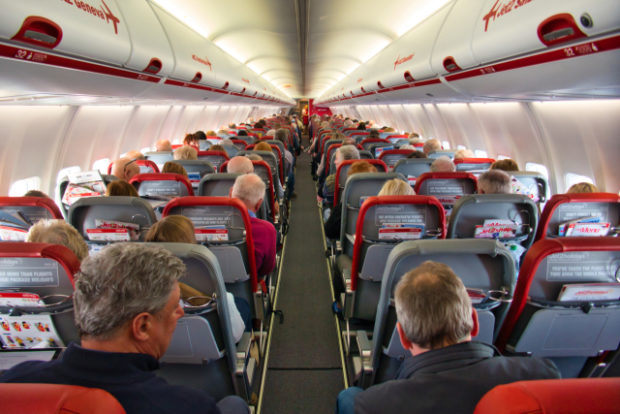
The International Air Transport Association backed the wearing of masks by both passengers and crew but said it did not support physical distancing measures that would leave the middle seat empty in a row of three.
There would be “dramatic cost increases” if such seats were left empty, IATA said in a statement, warning that airlines might otherwise go bust if they struggled to break even.
The aviation industry has taken a big hit in the coronavirus crisis, as lockdown measures and travel restrictions bite.
IATA said that evidence so far — which it admitted was limited — suggested the risk of virus transmission on a plane was already low.
Cabin environment
It said the reasons why this could be excluded is the fact that passengers face forwards, with limited face-to-face interaction, while seats provide a barrier to the person in front.
It said the airflow downwards from the ceiling to the floor further reduces the potential for transmission, while airflow rates are not high and “not conducive to droplet spread” as in regular indoor environments.
Meanwhile, High Efficiency Particulate Air (HEPA) filters on modern aircraft clean cabin air to hospital operating theater quality, said IATA.
“The cabin environment naturally makes transmission of viruses difficult,” said IATA chief Alexandre de Juniac.
“Our aim is to make the cabin environment even safer with effective measures so that passengers and crew can return to travel with confidence.
“Screening, face coverings and masks are among the many layers of measures that we are recommending. Leaving the middle seat empty, however, is not.”
Besides everyone adopting masks on board, proposed temporary measures to reduce the risk of infection include temperature screening of passengers, airport workers and passengers, and limiting movement in the cabin mid-flight.
More frequent and deeper cleaning measures are being considered, along with boarding and disembarking processes that reduce contact.
Immunity passports and testing for the novel coronavirus could also be included, in time.
Struggle to break even
Geneva-based IATA said that physical distancing measures on planes would “fundamentally shift the economics of aviation”.
It said the maximum load factor would be cut to 62% — well below the industry’s break-even figure of 77%.
Ticket costs would therefore have to go up by between 43% and 54% just to cover costs, said IATA.
“Airlines are fighting for their survival. Eliminating the middle seat will raise costs. If that can be offset with higher fares, the era of affordable travel will come to an end,” said Juniac.
“On the other hand, if airlines can’t recoup the costs in higher fares, airlines will go bust.
“Neither is a good option when the world will need strong connectivity to help kick-start the recovery from COVID-19’s economic devastation.” NVG
RELATED STORIES:
As car dealerships reopen, how will they adapt post-quarantine?
From Prosecco to Chianti, Italy’s wine sales sour from virus